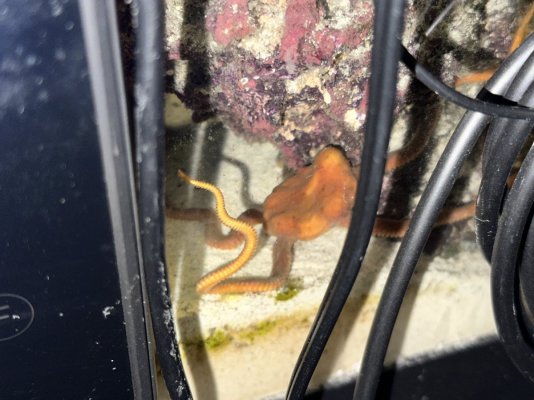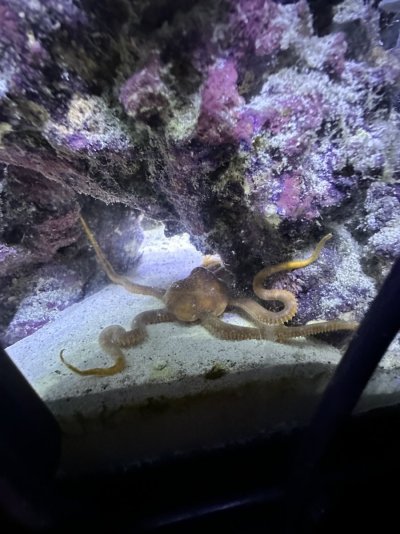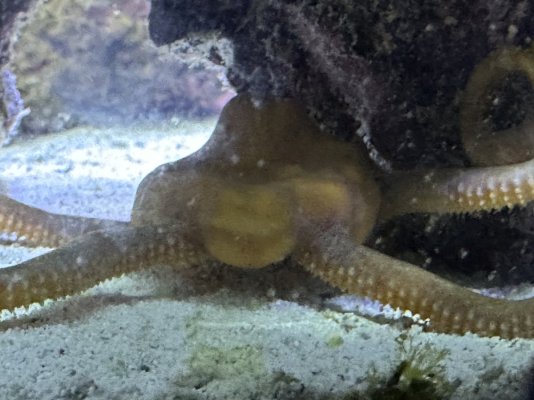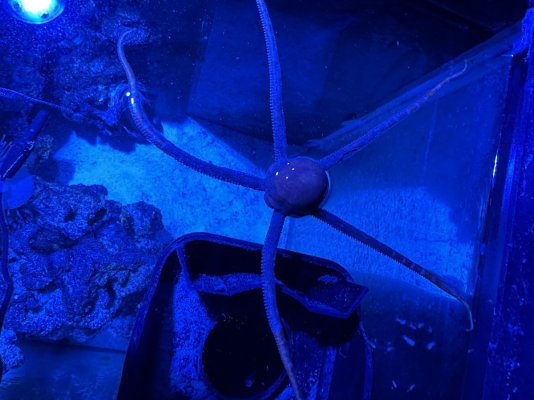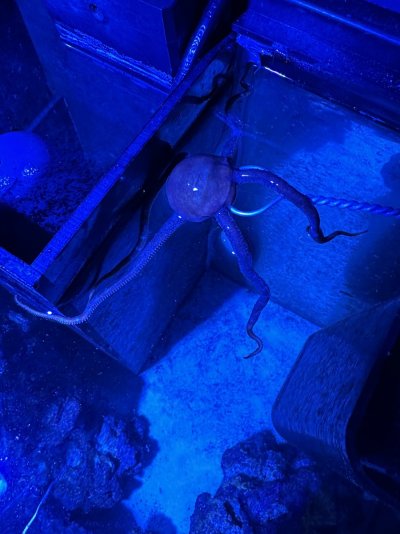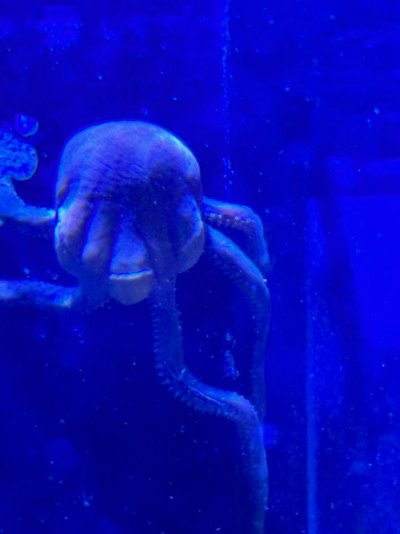Navigation
Install the app
How to install the app on iOS
Follow along with the video below to see how to install our site as a web app on your home screen.
Note: This feature may not be available in some browsers.
More options
You are using an out of date browser. It may not display this or other websites correctly.
You should upgrade or use an alternative browser.
You should upgrade or use an alternative browser.
Can you get a photo during the day? It’s hard to see/identify as the photo is dark and a bit out of focus. My guess is it’s some kind of growth but I’m not sure as stars and brittle stars diseases aren’t studied or well-known in the hobby and the scientific community.
My camera is having problems lately and is having trouble focusing, so unfortunately this is the best I can getCan you get a photo during the day? It’s hard to see/identify as the photo is dark and a bit out of focus.
Attachments
Is it eating anything? Or did it recently eat? All I can say is monitor it and keep up with maintenance. Unfortunately inverts aren’t like fish so if they get sick or something goes wrong we don’t really have treatments for them.My camera is having problems lately and is having trouble focusing, so unfortunately this is the best I can get
He is very active. He keeps climbing in my new internal tunze skimmer and I have to remove him each time. He eating plenty so I don’t know what the problem could beIs it eating anything? Or did it recently eat? All I can say is monitor it and keep up with maintenance. Unfortunately inverts aren’t like fish so if they get sick or something goes wrong we don’t really have treatments for them.
@ISpeakForTheSeas @livinlifeinBKK Thoughts?
I'd agree with @AydenLincoln, to my knowledge any kind of diseases for inverts are uncommon and I've not heard anything about treatments, really. I'd just keep an eye on it and try not to let it stress you out. Ultimately besides the aesthetics of the animal it seemingly is acting ok, so that's a positive. I'd try to not think too much about it but to regularly check in on it- it looks pretty big, so if it does die you def want to remove it relatively quickly to not let it affect your water quality. Wishing you the best!
I know this happens sometimes, but I'm not sure entirely sure why - it could be disease/injury related, it could be stress/environment related, it could be food related (such as if it ate something too large), it could be a species specific thing, it could be nothing, etc. In some species, the central disk will swell with brooding larvae (some ophiuroids - brittle stars - are viviparous, meaning they give birth to live young; some of them brood these young inside their central disks for a time) - this could be that, but I personally doubt it.
Sometimes swelling like this is an actual problem, and sometimes it goes away after a bit and the star is fine.
If I had to guess at a cause (pure speculation that may or may not have any actual basis in fact, as very, very little seems to actually have been studied with regards to ophiuroid ailments), I would guess something is preventing the star from adequately diffusing waste gases through their skin:

 www.reef2reef.com
www.reef2reef.com
Sometimes swelling like this is an actual problem, and sometimes it goes away after a bit and the star is fine.
If I had to guess at a cause (pure speculation that may or may not have any actual basis in fact, as very, very little seems to actually have been studied with regards to ophiuroid ailments), I would guess something is preventing the star from adequately diffusing waste gases through their skin:
Here's one relatively similar instance that hopefully won't happen to your star:stars basically just digest what they can, leave what they can't, and excrete the waste through their skin and tube feet. The quote below is a simple explanation:
"Excretion in echinoderms is by simple diffusion of metabolic wastes (ammonia) across thin permeable regions of the body wall. A variety of gas exchange structures, including the tube feet, is found in various echinoderms."
Source: https://biosurvey.ou.edu/Invert_manual/Echinodermata.html

Hole in Serpent Starfish
I received 2 Large serpent starfish yesterday. After drip acclimating them, I put them both in my tank. About two hours after getting them into the tank, one of them started to form a bubble in the top center. The bubble would inflate, and deflate. The bubble looked like it moved slightly. This...
 www.reef2reef.com
www.reef2reef.com
It sounds to me like a parasite. Although I'm not sure how it would have been introduced into your system, or the lethality (most parasites aim not to kill the host), all you can do is keep an eye on it for now. As to what it may be more specifically, sporozoa protists are known to infest the coelom and tissues of echinoderms which is a possibility. However, more closely matching your description of the appearance of a lump, I'd guess it's a parasitic species of copepod (which are fairly common in ophiuroids according to the literature). Telltale signs include gall formation in the body wall which are evident as lumps on the skin.
Thank you!I know this happens sometimes, but I'm not sure entirely sure why - it could be disease/injury related, it could be stress/environment related, it could be food related (such as if it ate something too large), it could be a species specific thing, it could be nothing, etc. In some species, the central disk will swell with brooding larvae (some ophiuroids - brittle stars - are viviparous, meaning they give birth to live young; some of them brood these young inside their central disks for a time) - this could be that, but I personally doubt it.
Sometimes swelling like this is an actual problem, and sometimes it goes away after a bit and the star is fine.
If I had to guess at a cause (pure speculation that may or may not have any actual basis in fact, as very, very little seems to actually have been studied with regards to ophiuroid ailments), I would guess something is preventing the star from adequately diffusing waste gases through their skin:
Here's one relatively similar instance that hopefully won't happen to your star:

Hole in Serpent Starfish
I received 2 Large serpent starfish yesterday. After drip acclimating them, I put them both in my tank. About two hours after getting them into the tank, one of them started to form a bubble in the top center. The bubble would inflate, and deflate. The bubble looked like it moved slightly. This...www.reef2reef.com
I’ll continue to monitor it and I will post back in this thread with the progress.I know this happens sometimes, but I'm not sure entirely sure why - it could be disease/injury related, it could be stress/environment related, it could be food related (such as if it ate something too large), it could be a species specific thing, it could be nothing, etc. In some species, the central disk will swell with brooding larvae (some ophiuroids - brittle stars - are viviparous, meaning they give birth to live young; some of them brood these young inside their central disks for a time) - this could be that, but I personally doubt it.
Sometimes swelling like this is an actual problem, and sometimes it goes away after a bit and the star is fine.
If I had to guess at a cause (pure speculation that may or may not have any actual basis in fact, as very, very little seems to actually have been studied with regards to ophiuroid ailments), I would guess something is preventing the star from adequately diffusing waste gases through their skin:
Here's one relatively similar instance that hopefully won't happen to your star:

Hole in Serpent Starfish
I received 2 Large serpent starfish yesterday. After drip acclimating them, I put them both in my tank. About two hours after getting them into the tank, one of them started to form a bubble in the top center. The bubble would inflate, and deflate. The bubble looked like it moved slightly. This...www.reef2reef.com
it seems to have gone down, not sure what caused thisAny updates?
I need help again and it’s gotten worse. He has now totally blown up like a balloon. And he is floating. He is very alive and I’m not sure what to do. I found him in my skimmer again, and my prediction is that all of the air from the skimmer has made him bloated. This is definitely air because I felt his body and it is very squish, not hard. I tried helping him back down to the sand bed or a rock, but we would just float back up. I do not know what to do.Any updates?
Attachments
I'm not sure what the best course of action would be here - you could try to help it deflate, or you could wait it out and see what happens. I have no idea if it would be wise to try and deflate it, so hopefully someone with better advice will chime in for you.He’s trying to go down but it the air is pushing him back up. All of the air has shifted towards the top of his body.
That said, if you do try to deflate it, you could try flipping it upside down (and possibly very gently squeezing it) to see if it is able to release the air that way. You might also be able to try something to help it release the gases itself by cleaning the top somehow too (possibly with a soft toothbrushing or a quick scrub with some iodine followed by a good, quick rinse; I honestly don't know what the best way would be to attempt something like this or if it would help - sorry). Those are the only ideas I have at the moment though.
Edit: the only other thing I can think of (which may be a bad idea) is taking a needle-less syringe (like the kinds you find with kids' tylenol and stuff), sticking it into the star's stomach like you're going to force feed it with the syringe, and trying to use it to suction some of the gas out - no idea if it would work, but seems as good of an idea as the other two I listed above.
Last edited:
He climbed straight back into my skimmer just about 30 min after I took him out. The skimmer is the reason he’s bloating, yet he goes straight back inI'm not sure what the best course of action would be here - you could try to help it deflate, or you could wait it out and see what happens. I have no idea if it would be wise to try and deflate it, so hopefully someone with better advice will chime in for you.
That said, if you do try to deflate it, you could try flipping it upside down (and possibly very gently squeezing it) to see if it is able to release the air that way. You might also be able to try something to help it release the gases itself by cleaning the top somehow too (possibly with a soft toothbrushing or a quick scrub with some iodine followed by a good, quick rinse; I honestly don't know what the best way would be to attempt something like this or if it would help - sorry). Those are the only ideas I have at the moment though.
Similar threads
- Replies
- 2
- Views
- 69
- Replies
- 6
- Views
- 209
- Replies
- 3
- Views
- 159


